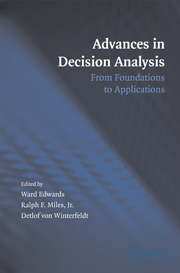Book contents
- Frontmatter
- Contents
- List of Contributors
- Preface
- 1 Introduction
- PART I HISTORY AND FOUNDATIONS OF DECISION ANALYSIS
- PART II STRUCTURING DECISION PROBLEMS
- PART III PROBABILITIES AND BAYES NETS
- PART IV UTILITIES
- PART V RISK ANALYSIS
- 15 Probabilistic Risk Analysis for Engineered Systems
- 16 The Engineering Risk-Analysis Method and Some Applications
- 17 Health Risk Analysis for Risk-Management Decision-Making
- PART VI DECISION ANALYSIS IN A BEHAVIORAL AND ORGANIZATIONAL CONTEXT
- PART VII APPLICATIONS OF DECISION ANALYSIS
- Index
- References
16 - The Engineering Risk-Analysis Method and Some Applications
Published online by Cambridge University Press: 05 June 2012
- Frontmatter
- Contents
- List of Contributors
- Preface
- 1 Introduction
- PART I HISTORY AND FOUNDATIONS OF DECISION ANALYSIS
- PART II STRUCTURING DECISION PROBLEMS
- PART III PROBABILITIES AND BAYES NETS
- PART IV UTILITIES
- PART V RISK ANALYSIS
- 15 Probabilistic Risk Analysis for Engineered Systems
- 16 The Engineering Risk-Analysis Method and Some Applications
- 17 Health Risk Analysis for Risk-Management Decision-Making
- PART VI DECISION ANALYSIS IN A BEHAVIORAL AND ORGANIZATIONAL CONTEXT
- PART VII APPLICATIONS OF DECISION ANALYSIS
- Index
- References
Summary
ABSTRACT. Engineering risk analysis methods, based on systems analysis and probability, are generally designed for cases in which sufficient failure statistics are unavailable. These methods can be applied not only to engineered systems that fail (e.g., new spacecraft or medical devices), but also to systems characterized by performance scenarios including malfunctions or threats. I describe some of the challenges in the use of risk analysis tools, mainly in problem formulation, when technical, human, and organizational factors need to be integrated. This discussion is illustrated by four cases: ship grounding due to loss of propulsion, space shuttle loss caused by tile failure, patient risks in anesthesia, and the risks of terrorist attacks on the US. I show how the analytical challenges can be met by the choice of modeling tools and the search for relevant information, including not only statistics but also a deep understanding of how the system works and can fail, and how failures can be anticipated and prevented. This type of analysis requires both imagination and a logical, rational approach. It is key to proactive risk management and effective ranking of risk reduction measures when statistical data are not directly available and resources are limited.
Engineering Risk Analysis Method: Imagination and Rationality
Risk analysis for well-known, well-documented and steady-state systems (or stable phenomena) can be performed by methods of statistical analysis of available data. These include, for example, maximum likelihood estimations, and analyses of variance and correlations.
Information
- Type
- Chapter
- Information
- Advances in Decision AnalysisFrom Foundations to Applications, pp. 302 - 324Publisher: Cambridge University PressPrint publication year: 2007
References
Accessibility standard: Unknown
Why this information is here
This section outlines the accessibility features of this content - including support for screen readers, full keyboard navigation and high-contrast display options. This may not be relevant for you.Accessibility Information
- 9
- Cited by
